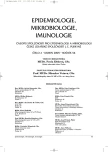Czech Term for Rods
Tyče, tyčky, tyčinky
Pro označení bakterií podlouhlého tvaru užívají v poslední době někteří stále častěji termín tyče. Je možné, že důvodem jsou texty v angličtině, kdy slovo rod slovníky překládají na prvním místě jako tyč. Podrobnější analýza ale ukazuje, že anglické rod lze do češtiny překládat i jako tyčka nebo tyčinka. V klasických českých učebnicích a příručkách lékařské mikrobiologie autoři používají vesměs jen termín tyčinky. Z historických i jazykových důvodů by se v oficiálních textech termín tyčinky měl užívat i nadále.
Klíčová slova:
bakteriologická terminologie – tyčinky.
Authors:
M. Votava
Authors‘ workplace:
Mikrobiologický ústav LF MU a FN u sv. Anny v Brně
Published in:
Epidemiol. Mikrobiol. Imunol. 54, 2005, č. 2, s. 62-64
Overview
With increasing frequency, the rod-shaped bacteria have been recently referred to in Czech as tyče (the singular is tyč) instead of the diminutive tyčinky (the singular is tyčinka) as used in classical Czech textbooks and handbooks of medical microbiology. This discordance might result from inadequate translation of the English term rods. Although the English-Czech dictionary gives three equivalents for the analyzed meaning of this word, i.e. tyč, tyčka, tyčinka, the first option, a monosyllable as the English rod is, is often selected without further consideration. Nevertheless, such simplification is not justified; to avoid confusion it is preferable to use conventional terminology.
Key words:
bacteriological terminology – rods.
Labels
Hygiene and epidemiology Medical virology Clinical microbiologyArticle was published in
Epidemiology, Microbiology, Immunology

2005 Issue 2
Most read in this issue
- Factors of Virulence and Mechanisms of Resistance to Aminoglycosides in Clinical Isolates of Enterococcus faecalis and Enterococcus faecium with High-level Gentamicin Resistance
- Congenital Toxoplasmosis: Possibilities for Laboratory Diagnosis
- Immunological Monitoring of Sepsis Using Flow Cytometry – Quantitation of Monocyte HLA-DR Expression and Granulocyte CD64 Expression
- Microbicidal Efficacy of a New Foam Disinfectant
